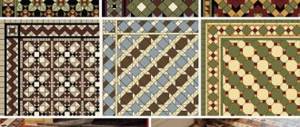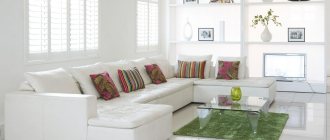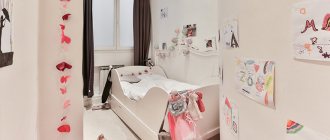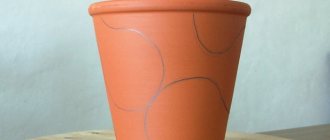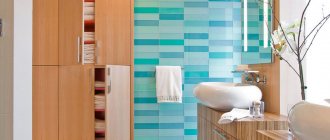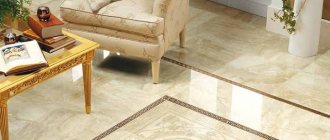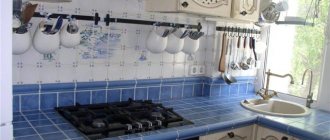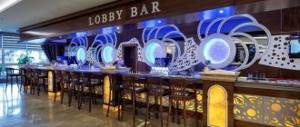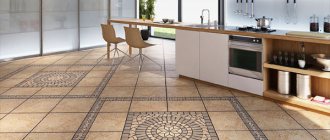The use of mirror tiles in the interior
The use of mirror tiles in a residential area allows you to solve several problems at once:
- expressively decorate the space;
- visually expand the room;
- visually make the room brighter;
- decorate the walls with strong, durable material that does not leave scratches.
If previously mirror finishing materials were found exclusively in the bathroom, today these boundaries have expanded significantly. And beveled mirror tiles can be used almost endlessly in the interior. During its production, the chamfer is removed, the result is an exquisite thin material that fits well into the most elegant design solutions.
About the advantages and disadvantages of mirror tiles
Glass-based facing materials are made using the damping method - crystalline, gaseous or amorphous substances (silencers) are added to the glass melt. They give the finished material limited transparency and optical heterogeneity.
Mirror wall tiles for the bathroom today are not quite a common finishing material. In addition, many are distrustful of its use in the bathroom, believing that it is more difficult to remove dirt from the mirror cloth, and it easily breaks down during use.
The main advantages of mirror tiles include:
- durability;
- resistance to acids and alkalis;
- not flammable;
- easy care during use
- high decorative properties (bright colors, shiny surface).
- The mirror canvas visually enlarges the space.
The main disadvantages of mirror tiles:
- may be scratched or broken if transported incorrectly;
- Over time, the mirror fabric in the bathroom may darken.
Please note that a properly functioning ventilation system in the room will help to avoid darkening of mirror tiles.
Living room decoration
When decorating a living room, several materials are combined. Mirror tiles in the living room interior are appropriate on the walls, ceiling or floor. It is advisable to include one mirror layer in a multi-level ceiling. It will visually increase the height. It is not worth making the ceiling entirely mirrored, otherwise the effect of an inverted space will interfere. You should also avoid mirror surfaces on two opposite walls. This creates a tunnel effect and makes it difficult to relax. If you absolutely want to design two opposing walls in this way, then you need to attach the material at different levels, then mutual reflection will not work.
Well-thought-out lighting will contribute to a comfortable stay in a living room with mirrored tiles. Recreation areas should be organized so that the light reflected in the mirrors does not fall on a person. Otherwise, it will be tiring and will negatively affect your vision.
A mirrored floor makes its own demands on the interior. Everything that is reflected in it will become an integral part of the appearance of the space. Therefore, you need to think through everything down to the smallest detail. You should also think about reflection when decorating mirror walls. If you place bulky furniture in front of them, it will be reflected and visually make the room small and cluttered.
Secrets of decorating walls with mirror tiles
Mirror tiles will help make a small bathroom room more spacious.
There are several secrets, the use of which allows you to decorate walls with mirror tiles correctly:
- It is not advisable to fix mirror tiles on two opposite walls . This technique creates the illusion of a narrow tunnel, which, in conditions of limited bathroom space, negatively affects the overall perception of the interior;
- a mirror panel framed in a decorative frame can become the central element of the interior;
- You can visually raise the ceiling by lining up vertical stripes of small width on the walls;
- You can fill the bathroom with light by laying mirror tiles on the wall located opposite the light source;
- niches in the bathroom lined with mirror elements visually look deeper and more voluminous;
- When laying bathroom walls with ceramic and mirror tiles, you must ensure that the elements match in size.
Kitchen decoration
The food preparation area and dining room are characterized by the accumulation of fats and other dirt. Therefore, mirror tiles in the kitchen interior, although they look chic, but only until they become covered with unpleasant stains. If you are willing to devote time and effort to caring for it, then this material will be the best option for finishing. Mirror surfaces will look especially impressive next to glossy furniture and glass surfaces.
Furniture and interior items
71 votes
+
Vote for!
—
Vote against!
Using mirrors in the interior is a great way to significantly change the decor, expand the space, and make it deeper. And this applies to absolutely any mirror coatings, be it full-fledged structures, or decoration using mirror tiles or mosaics. This type of finishing has many advantages. It is used in the interior of residential premises, for example, in the design of a bathroom, kitchen or corridor. And also for cladding public buildings - shopping and entertainment centers, office foyers, cinemas, restaurants and other establishments. This article will talk about mirror tiles in the interior.
Mirror surfaces do not require complex maintenance and such products are relatively easy to install; in addition, the characteristics of the tile allow it to be used for a long service life.
- Often mirror tiles are presented in the form of mirror sections of a certain shape. The edges can be processed and become safe and aesthetically pleasing. It is possible to produce custom-made tiles, the edges of which will be beveled - beveled tiles. But it is uncomfortable to perceive your reflection in it, since it turns out to be fragmentary and partial. However, the material itself becomes more elegant and sophisticated.
Mirror tiles in the interior photo
Features of mirror tiles
Making mirror tiles
- The process of producing mirror tiles is slightly different from the production of ceramic tiles that are familiar to many (for which the method of pressing a clay mass and firing it is used). In factories that produce mirror tiles, the process of cutting large sheets into individual elements of the required size and planned shape is carried out.
- The mirrors themselves are produced using the jamming method. That is, special compounds are added to the molten glass mass, which are gaseous crystalline substances called mufflers. They are what give the finished product a mirror shine.
- The received raw materials for further processing can have different thicknesses, starting from 4 mm. The standard size of the finished product can vary from 9.5x9.5 cm to 30x30 cm. Usually, the shape chosen is square, but it can also be rectangular, diamond-shaped and even triangular. Of course, when making products to order, you can choose any possible parameters.
- After the tiles have been cut, they go to the workshop for grinding and polishing. An important stage of work is to properly process the edges so that they do not pose a threat to further use. Also, the edge, depending on the developed design, can be polished, matte, or with cut bevels (a bevel along the edge of the product that is decorative in nature). Due to this processing, the finished product is reduced in size by approximately 1.5 mm from its original parameters. And this is exactly the value that tiles can differ from each other even in the same batch.
- In addition, mirror tiles can be made from a material such as polystyrene. The top of this product is covered with a plastic layer. A distinctive feature of this product is that it is quite easy to cut, and it is also possible to paint it in a variety of colors and create embossing on the surface. However, due to the unsatisfactory indicator of environmental safety, it is used a little less often than glass elements.
- In order to create any pattern on the surface, manufacturers most often use sandblasting. That is, at high pressure, sand is applied to the surface of the glass using a pre-made template. In this case, the drawing itself will have a matte finish, and the rest of the product will have a glossy shine. It is also possible to apply images with paint or thermal printing, but such methods do not always allow the surface to remain unchanged for many years.
There are 3 main options for creating mirror planes:
- mirror tiles;
- mirror polystyrene plates . They are represented by ordinary polystyrene slabs, the front side of which is coated with paint containing tiny metal particles. Its advantages are its affordable price, ease of installation, and its disadvantages are the low quality of reflection, the image is blurry;
- self-adhesive mirror tiles . This option for creating mirror decor is the easiest to install. The elements are presented in the form of tiles, consisting of an outer mirror layer and an inner layer attached to the base. The thickness of the material is only 5mm. To apply such tiles, it is necessary to create a perfectly flat surface. The entire installation consists of removing the protective film from the inner surface and applying the material to the base. This material is securely attached to the surface and does not require additional finishing processes. But its cost is much higher than glass tiles.
Advantages and disadvantages of mirror tiles
Positive qualities of mirror tiles:
- long service life;
- versatility of use;
- a variety of design solutions, the surface of the material can have different colors (gold, silver, bronze or chrome), be smooth or embossed, and also have inserts (square, in the form of embossing or any stripes and lines), in addition, there is an option , in which a holographic pattern is applied to the top layer;
- has sufficient flexibility that it allows you to veneer even curved structures (niches, columns, etc.);
- fire resistance;
- resistance to chemical reagents, including acids and alkalis;
- high corrosion resistance and moisture resistance;
- easy care;
- environmental Safety;
- visual expansion of the room;
- Possibility of self-installation and easy replacement of components.
Flaws:
- fragility of the product, that is, a more careful and careful attitude is required compared to other finishing materials, since in cases of damage to the products, there is a high probability of injury;
- with prolonged use in conditions of high humidity, the surface may change and darken; of course, this process can be slowed down and even completely prevented by using well-functioning ventilation and carefully insulating the seams;
- high price of products compared to other similar cladding options.
Technical characteristics of mirror tiles
- The most important parameter is high reflective ability (more than 90%). Due to this indicator, it became possible to fill with light even those rooms where the level of illumination is minimal. It is important to arrange the lighting fixtures correctly, and it does not matter how many of them are used.
- The next characteristic is excellent moisture resistance and resistance to chemicals. This parameter also affects the resistance of the product to atmospheric phenomena. That is, it is allowed to use tiles in rooms where conditions are far from ideal. In addition, due to its immunity to elements such as ammonia and acid, even chemical detergents based on them can be used to clean the surface.
- The mirror coating is produced using a special technology, due to which the product does not contain copper and lead impurities, which are actively used to create a protective layer for household mirrors.
Features of installing mirror tiles
- Mirror tiles can be mounted on almost any surface; in particular, they look good on walls or ceilings. There is also a common option in which mirror-coated tiles are combined with ceramic products. Of course, it will be difficult for an unprepared person to immediately install mirror panels or mosaics, because unlike tiles, whose back side has a relief or rough surface, this tile has an even and smooth texture.
- So, in order to start laying tiles, you need to properly prepare the base. It must have almost perfect evenness. After all, any defects will lead to the fact that it will be impossible to achieve a uniform mirror surface. Roughness or waviness will immediately be reflected on the installed product, and this will lead to image distortion. Surface preparation is carried out in the same way as in cases with other cladding methods.
- When the base is prepared, the tiles should be laid out in the order in which they are planned to be installed. Since not all elements are identical in size even in the same batch (differences can be up to 3 mm), this must be taken into account before installation begins. It is also better not to use the method of cutting edges, since initially all products have edges processed in a special way, and if they are removed, the appearance will noticeably deteriorate.
- But if it is necessary to adjust the material to size, then use a glass cutter. With its help, the tiles are adjusted to the required size and shape. It is necessary to work carefully to prevent the formation of chips and cracks in the material.
- The first row must be laid horizontally. It is best to leave joints between the tiles, but no more than 4 mm, this will help maintain the pattern throughout the entire surface. That is, when mounting the products closely, after several rows you can notice that the edges no longer match and the entire pattern “floats”.
- Silicone-based glue is applied to the first mirror tile from the back side with a spatula. Then the decorative element is applied to the place where it will be located, placing it within the outlined boundaries, pressed to the surface and held for some time until the adhesive composition sets.
- Then a plastic cross is placed on the edge of the tile, the thickness of which corresponds to the desired width of the seam. You should not make seams that are too wide, otherwise the integrity of the reflection will be compromised. The next element is placed next to the first element, etc. All panels are laid out in this way. Laying tiles, especially mirrored ones, requires leisurely, precise movements. Mirror elements should only be pressed to the base with a soft cloth, otherwise you can damage the surface and leave unpleasant scratches or stains.
- There are several different ways to attach mirror tiles to walls. First of all, you need to take into account the parameters of the product itself. So, if the reverse side is opaque, then it can be coated with a mixture of bitumen and sand, but if the product is completely transparent, then it is permissible to use a composition of liquid glass mixed with part of the sand. In general, mirror products can be mounted on silicone solutions or liquid nails; it is important to pay attention that there are no acids in the composition, otherwise unpleasant stains may appear on the front side.
- Mirror tiles are attached to a suspended ceiling using screws. The fastener caps are hidden under chrome-plated plugs. This is a labor-intensive, responsible process, but more reliable. Not a single tile will fall from the ceiling.
- After the installation is completed and you are completely satisfied with the result, the lined surface is left to dry for several days (about 2-3 days, depending on the gluing method). After this period, the seams should be grouted with silicone grout, which does not contain acids. This product is ideal for bathrooms or kitchens, as it does not allow moisture to penetrate between the tiles, which means that the likelihood of dark spots appearing on the front side is reduced.
- The final step is to polish the mirror finish with a soft cloth. This is done after the grout has completely dried. It is important to maintain evenness during installation; each laid row must be checked using a building level.
Basic space design techniques
- Since mirror tiles or panels can have different shapes, sizes, as well as design solutions, there are many options for incorporating them into the interior. In any case, glass products are always appropriate indoors and no matter what style was chosen - classicism, baroque, oriental, gothic, antique, hi-tech or even minimalism. For example, artificially aged mirrors are ideal for almost all classical trends.
- Since the shape of the mirror elements can be different, this can be used to advantage in the design. For example, tiles in the shape of a diamond or rectangle can expand the space, but at the same time, without becoming the center of the composition. There is also an option in which the large central mirror will be framed by small triangular or square elements. It is no longer easy to cover the surface of a wall or ceiling; it is the art of creating panels.
- In general, the panel can be ready-made, that is, the manufacturer independently chooses the shape of the products, what elements they will consist of and in what sequence installation is required. If this method of creating an interior is not optimal, then you can always create a composition yourself.
- The peculiarity of mirror finishing is that it allows you to visually enlarge the space around and make it lighter and more comfortable. Beveled tiles are most often used in the interior. Due to the beveled edges, this design looks as elegant as possible, while the tiles seem almost weightless.
- The traditional place for laying tiles is the bathroom or kitchen. But this does not mean that it is inappropriate in the living room or bedroom. So, if the house has a small room, then to expand it, it is enough to decorate the wall opposite the window with mirror tiles. In this case, it is important to take into account that the surface of the mirrors should not be exposed to direct sunlight, which is why it is recommended to install the panel slightly above the window level. You should not fill large areas of the walls with mirrors, so as not to turn the room from cozy to cold. The mirror should act as an auxiliary tool, an element that hides the shortcomings of the premises.
- If it is necessary to achieve the opposite effect, that is, a narrowing of space, then it is recommended to dilute the mirror elements with other materials, that is, do not use a single canvas. This technique is perfect for large living rooms or hallways. But if you use it in a small room, you can forget about the harmonious and cozy atmosphere.
- Another rule is that mirrors should not be installed on two opposite surfaces. That is, when one wall will be displayed in another. This tires the eyes and psyche, therefore, if it is required that the tiles be on each wall, then it is recommended to mount them at different levels, avoiding mutual reflection.
- When you need to visually raise the ceiling, a mirror ceiling covering is best suited for this purpose. Moreover, experts advise using a seamless installation method. In addition, it is important to properly complement the decoration with light sources. There is also an option in which only the central part of the ceiling is decorated with mirror inserts, and the rest of the space has a multi-level ceiling. Here it is important to correctly calculate the design parameters, otherwise you can achieve the opposite effect - reducing the height of the room. If decorating the ceiling was not included in the plans, then you can use this solution - decorate the lower part of the room with mirror products. This will also increase the height of the walls and at the same time expand the space.
- Of course, the decision to decorate a kitchen or bath with mirror material is considered more common. Tiles in the kitchen allow you to expand the space, make it more comfortable and bright. Here, mirror elements can be combined with furniture made of glass or with a glossy surface. It is best to decorate only one wall with mirrors, for example, it can be a large panel in the center of the wall, or a kitchen apron. But since drops of fat from cooking food settle on kitchen surfaces, it is worth using smaller tiles for tiling. On solid, large canvases, dirt and grease will be very noticeable.
- As for the bathroom, it is allowed to use mirror finishes on all walls and even on the ceiling, if the room does not have sufficient lighting. But still, if you completely cover a room with mirror tiles, it will turn out faceless and cold. It is recommended to place a mirror accent on one of the surfaces. For example, the decor of mirror stripes in the bathroom, placed along the entire height of the walls, looks very original. The tiles are attached to moisture-resistant drywall, behind which all communications are hidden.
- If you have a large space, it is recommended to use mirror tiles for the bathroom as a decorative element. That is, combining it with other materials, for example, a mirror surface in combination with black tiles looks very advantageous. It is important to take into account that when combining products of different compositions, it is best if they have the same dimensions.
Golden rules for using mirrors in the interior:
- To visually enlarge the room, wall cladding should be selected in light colors. The tile is placed so that it reflects the window opening;
- if the mirror plates are framed, this prevents the room from expanding. The thicker the frame, the smaller the room appears;
- For finishing with mirror slabs, choose a wall that will not create the effect of the presence of strangers. It is best to place mirrors on the side of the entrance, behind the sofa.
Caring for mirror tiles
- Like any other type of finish, mirror tiles also require regular maintenance. Only by carrying out certain procedures in a timely manner can you maintain the attractiveness of the product and preserve its natural shine. First of all, as an everyday activity, it is recommended to treat the surface with plain water, that is, wipe the mirrors with a slightly damp soft cloth.
- If stains or persistent dirt appears on the front of the products, you can use special cleaning products for mirrors or glass. In addition, you can use folk recipes, for example, dilute table vinegar in warm water and wipe the surface with this solution.
- Of course, it is worth adhering to a number of restrictions. It is forbidden to wipe mirrors with a hard brush or preparations that contain abrasive particles. Since such treatment will lead to scratches, which will not only spoil the appearance, but will also become a place for the active reproduction of microorganisms.
- After the mirror tiles have been cleaned with water or liquid products, it is necessary to rub the surface with a soft, dry napkin or cloth. This procedure will restore its shine and beauty. To ensure that the product retains its original appearance for as long as possible, exposure to direct sunlight should be protected and high humidity should be avoided. In addition, you can use special protective agents that create an antistatic effect on the coating, so the tiles will attract less dust and become dirty.
- The average cost of one tile ranges from 150-500 rubles. The price is determined by the manufacturer, a specific collection, as well as the main parameters (shape, size, color, and so on). But such an investment fully pays for itself with the beauty that a mirror finish can give. Of course, when choosing this option for cladding, you should take into account many facts, not least of which is the illumination of the room. After all, only with the correct placement of lamps can you achieve a truly stunning effect, in which you observe the expansion of space and its saturation with light.
Thanks to mirror tiles, you can turn any design ideas into reality. This product can be used not only for finishing walls or ceilings, but also for decorating niches, furniture, openings, columns, fireplaces and many other architectural elements. It is important to follow the rule of harmonious combination of the mirror surface with the rest of the interior, and then you can really create the most comfortable conditions.
Bathroom decoration
Traditionally, mirror tiles in the bathroom interior, as in the photo, are used very widely. It can be used to lay out one of the walls or completely cover all surfaces. In any case, it makes an impression and looks expensive. There is only one drawback to this solution: hot water causes the mirrors to fog up. But this effect disappears after the humidity and temperature decrease.
The combination of simple ceramics and mirror finishing materials looks original. In this case, experts advise taking tiles of the same size.
In conclusion, it must be said that such material has a significant “minus”: it is difficult to work with. A perfectly prepared surface and carefully executed cuts are required. So only professionals can install it.
Secrets of finishing the ceiling with mirror tiles
The reflective properties of a mirror are most clearly manifested in small rooms (for example, a bathroom) . There are several secrets that help you properly decorate the ceiling with mirror tiles:
- Only a small area of the ceiling is decorated with mirrors. Most often this is the center of the shelf surface;
- A ceiling lamp will help highlight the beauty of the mirrors on the ceiling;
- The type of mirror tiles is selected depending on the materials of the ceiling surface. Concrete or plasterboard structures can support real mirror tiles. It is better to fix lighter plastic-based tiles on suspended ceilings.
Related article: 5 cool ways to use baskets in your apartment
Photo of mirror tiles in the interior
Share this important information with your friends on social networks!

